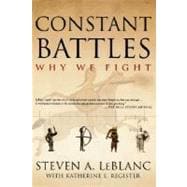
Note: Supplemental materials are not guaranteed with Rental or Used book purchases.
Purchase Benefits
What is included with this book?
| ACKNOWLEDGMENTS | ix | ||
| PROLOGUE: Finding Warfare in All the "Wrong" Places | xi | ||
| chapter one Warfare and Ecology: Myth and Reality | 1 | (22) | |
| chapter two Was There Ever an Eden? | 23 | (32) | |
| chapter three Enter Conflict | 55 | (22) | |
| chapter four Our Earliest Past | 77 | (23) | |
| chapter five Warfare Among Foragers | 100 | (28) | |
| chapter six Conflict and Growth Among Tribal Farmers | 128 | (29) | |
| chapter seven Complex Societies | 157 | (42) | |
| chapter eight War or Peace for the Future? | 199 | (32) | |
| NOTES | 231 | (14) | |
| LIST OF ILLUSTRATIONS | 245 | (2) | |
| REFERENCES | 247 | (18) | |
| INDEX | 265 |
The New copy of this book will include any supplemental materials advertised. Please check the title of the book to determine if it should include any access cards, study guides, lab manuals, CDs, etc.
The Used, Rental and eBook copies of this book are not guaranteed to include any supplemental materials. Typically, only the book itself is included. This is true even if the title states it includes any access cards, study guides, lab manuals, CDs, etc.
Excerpted from Constant Battles: Why We Fight by Steven LeBlanc, Katherine E. Register
All rights reserved by the original copyright owners. Excerpts are provided for display purposes only and may not be reproduced, reprinted or distributed without the written permission of the publisher.